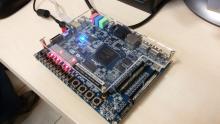Microprocessor Laboratory
Lab Image:


Related Classes: EE443 (Microprocessors)
Equipments:
- 20 evaluation boards of DE1-SoC donated by Altera University Program, used to experiment with 32-bit microprocessors of Arm Cortex A9. These boards have Altera’s Cyclone V system-on-chip (SoC). It is manufactured using 28 nm technology. One part of it is FPGA, which can be used to form peripherals or interfaces and the other part is hard-wired Hard Processors System (HPS), which features the ARM microprocessors.
- 5-10 Personal Computers (Intel Core i5-4590, 3.3 GHz, 6 MByte smart cache, 8 GByte RAM, 120 Gbyte SSD Disc, 400 Gbyte Sata Hard Disc, Flat LCD Displays) installed with 64-bit Windows 7 Professional, Altera’s Monitor Program and Altera’s Quartus II.
- 8 oscilloscopes (Hameg, HM203, 20 MHz), used to measure pulse width, frequency and period in experiments related to the usage of the timer modules of SoCs.
- 10 PS/2 keyboards, used in experiments teaching how to communicate with SoC through PS/2 interface.
Purpose:
Students use this laboratory to gain experience on registers, addressing modes, instruction sets, memory structure, interrupts, serial communication interface (SPI and I2C), analog to digital conversion unit, and timing unit of system-on-chips (SoC) or microcontrollers. Studied microprocessor is ARM Cortex A9, a 32-bit microprocessor. The SoC is Altera’s Cyclone V. Software such as Altera’s Monitor Prgoram and Altera’s Quartus II running on the PCs in the laboratory, are used to write Assembly and C codes intended for this SoC. Experiments are done using evaluation boards of these SoCs.

Lab Page:
Teaching